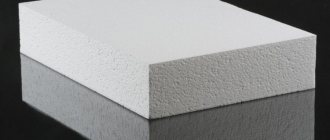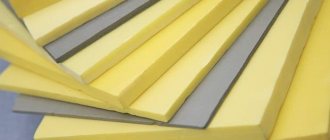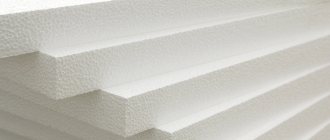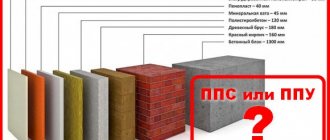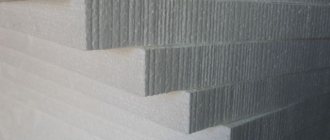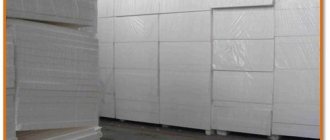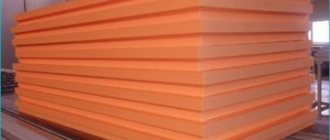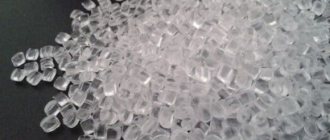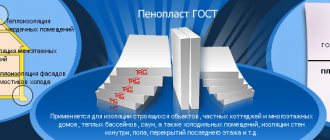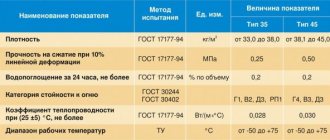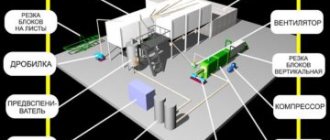There is a large selection of thermal insulation materials, among which façade polystyrene foam grade PSB S 25F is in great demand. In terms of strength and thermal conductivity, it is considered one of the best. It is used in various construction tasks: it is used to sound and heat insulate facades (including the “wet facade” method), roofs, and balconies. This foam has a medium density. Using it, they make figured decorative elements, create walls and partitions.
Figure 1. Foam plastic
Types of foam
The raw material for the manufacture of the material is polystyrene and its derivatives. The following types of pressless foam are distinguished:
- PSB – ordinary;
- PSB-S – self-extinguishing.
A distinctive feature of PSB S 25F is its surface with high adhesive properties. Thanks to its even and smooth structure, painting and plastering work is easier. This variety is made from smaller granules, compared to the PSB-S 15 and PSB-S 25 brands.
The production method of the material is different, which is why the products are divided into two large classes. For the production of the first (non-press) ones, high temperature is used, leading to sintering of the granules. For the second (press) granules are kneaded at elevated temperatures, adding a special foaming agent to the composition. The final stage of production is removal from the extruder.
Two letters are used as markings - PS. Pressless varieties are designated as PSB. The most common brands:
- PSB-S-15. Due to its low density, it is more suitable for insulating those places that do not require high mechanical strength. Demanded for insulation of: attics, roofless roofs, containers, carriages. Among the advantages: high moisture resistance, environmentally friendly and not “afraid” of the influence of microorganisms;
- PSB-S-25. The most popular and versatile brand. It is used to insulate: walls, floors, loggias, facades. The advantages are the same as the first type;
- PSB-S-35. This expanded polystyrene is used to insulate foundations and underground communications. Good because it is suitable for regions with unfavorable climate;
- PSB-S-50. The difference is the highest density. It is used in situations where it is necessary to achieve high mechanical strength. Areas of application: construction of roads in wetlands, construction and insulation of interfloor floors, garages, industrial zones.
There are even more types of foam, each with its own properties and characteristics.
Material grades
The production of material of various fractions becomes possible through the use of special chemical components and manufacturing technologies. Each of them has unique properties.
The presence of certain types of expanded polystyrene becomes indispensable when it is necessary to perform specific tasks in construction and repair. Today, the following highly demanded brands of expanded polystyrene are distinguished: PSB S-15, PSB S-25, PSB S-35.
The abbreviation stands for “suspension pressless polystyrene foam.” The second C stands for “self-extinguishing.”
Facade polystyrene foam PSB with 25f - characteristics
Main parameters:
- density – 15 – 25 kg/m3;
- compressive strength – minimum 0.1 MPa;
- bending strength – 0.18 MPa;
- thermal conductivity – no more than 0.039 W/m2*C;
- water absorption - maximum 2% of the total volume (during the day);
- vapor permeability – 0.05 mg/(m*h*Pa);
- operating temperatures – from -60 to +80 degrees Celsius;
- service life – from 20 to 50 years.
Industrially, this 25F facade foam is produced in the form of slabs, the thickness of which varies from 20 to 500 mm. The sheet sizes are as follows: 1000 by 1000 mm, 1000 by 1200 mm and 1000 by 2000 mm. If necessary, smaller slabs are cut.
PSB S-15
Lightweight expanded polystyrene boards of the PSB C-15 brand are the cheapest material in this series. Externally, the thermal insulation base consists of slabs of fused white granules. This expanded polystyrene is environmentally friendly, perfectly repels moisture, “does not age” and is not exposed to microorganisms.
Characteristics
The main distinctive qualities of polystyrene foam PSB-15:
- density is about 10-12 kg/m3;
- compressive strength – 0.04 MPa;
- thermal conductivity index – 0.043 W (mK).
Application
PSB-15 foam is used mainly when it is necessary to insulate building structures that are not susceptible to significant loads and intense exposure to environmental factors. The use of such foam plastic seems appropriate for insulating attics, wooden floor coverings, interior partitions, and residential temporary containers.
Polystyrene foam with brick finish
These facade expanded polystyrene foams belong to a separate type and are called “brick-like” imitation. This reinforced insulation consists of two layers: expanded polystyrene and a coating of polymer concrete.
Available in the form of square slabs, already decorated on the outside. For this reason, additional processing of the material is not necessary. All that remains for the customer is to mount the products on the walls, securing them with special glue.
The role of the outer layer is to decorate the facade of the house and protect the 25F foam from mechanical and atmospheric influences. Reinforced brick-like layers are made from: sand, cement, water and polymer additives. This makes the foam façade resistant to frost, fire and moisture.
The texture of the brick is perfectly conveyed by the smooth concrete surface. Additional façade foam is not required. The slabs are mounted using glue or special anchors. This type is popular because it reduces the time spent and the cost of exterior finishing of the house.
PSB S-35
Compared to polystyrene foam boards of the previous brand, this type of material has higher strength and also has low thermal conductivity.
PSB S-35 foam plastic is in demand when it is necessary to perform work where the ability of the insulation to withstand serious mechanical loads comes first.
Specifications
- density – 26-27 kg/m3;
- thermal conductivity index – 0.038 W (mK);
- compressive strength – 0.14 MPa.
Application area
Expanded polystyrene grade PSB S-35 is used as insulation in the construction of flat roofs, floors and ceilings that are subject to increased mechanical loads. The material demonstrates high efficiency when insulating basement floors and foundations of permanent structures.
PSB S-35 foam is used when it is necessary to protect the soil from freezing. In particular, such slabs become indispensable when laying coverings for sports fields and thermal insulation of swimming pools.
The use of polystyrene foam PSB S-35 allows you to avoid freezing of foundations during construction in areas with groundwater close to the surface.
Advantages and disadvantages - façade polystyrene foam PSB with 25f
Facade PSB is characterized by the following additional characteristics and properties:
- light weight and excellent thermal insulation properties. This provides the composition: 2% - polystyrene foam, 98% - small air pores;
- durability and absence of “material fatigue” effect. Facade products easily allow air to pass through them without collapsing. Even if moisture gets on it, the volume will remain the original;
- During operation, transportation or installation, PSB S 25F does not generate dust and does not emit harmful substances into the air. Suitable for installation on the facades of buildings for any purpose, from medical institutions, residential buildings to industrial enterprises;
- resistance to chemical compounds, temperature;
- façade material is easy to cut and process. Suitable for the production of decorative figured elements of various sizes. Due to its low weight and ease of processing, the cost of thermal insulation work is reduced;
- the performance characteristics of facade slabs are preserved even if they are exposed to aggressive substances (weak alkalis, acids, alcohols, saline and adhesive solutions, gypsum, water-soluble paints, and so on);
- biologically safe material on which microorganisms, fungi and mold do not develop;
- A fire retardant is added to the composition of facade foam 25F, which is necessary for spontaneous extinction of the material (in the absence of a fire source).
Flaws:
- the slabs have to be protected from the outside due to their low resistance to mechanical stress;
- heating more than +80 degrees leads to loss of material integrity and performance characteristics;
- organic solvents can ruin the foam.
The positive qualities outweigh the negative, especially considering the affordable price of polystyrene foam.
PSB S-25
Medium density polystyrene foam boards. The most popular brand of material. Designed specifically for insulation of building facades.
It features optimal qualities for such purposes: ideal density and high fire resistance. In addition to creating high-quality thermal insulation, the installation of PSB S-25 foam plastic helps to improve the sound insulation of structures.
Properties
- density from 15 to 17 kg/m3;
- thermal conductivity – 0.041 W (mK);
- compressive strength – 0.08 MPa.
Scope of use
Expanded polystyrene boards PSB-25 are used for insulation of walls, facades, floors, attics, loggias, roofs in buildings for various purposes. More often, the material is laid using the wet installation method under plaster.
It is recommended to use such foam plastic for heat and sound insulation of structures that are subject to significant mechanical loads. Thanks to their unique characteristics, the use of PSB-25 slabs becomes possible for pipeline insulation.
Installation
Facade thermal insulation should be installed in dry and windless weather. Permissible temperatures are from +5 to +25 degrees Celsius. First of all, carefully prepare the working surface. Stages of work:
- All elements are removed from the wall (gutters, lamps, etc.). Protrusions in the form of stucco or masonry above the surface level are dismantled. If you want to leave them, you will have to use more insulation (laid on the sides and top). Old plaster, dust and dirt are removed from the wall. Using a level or a long rule, check the evenness of the plane. Next, the wall is coated with a deep penetration primer and left to dry.
- Install the starting profile necessary to hold the sheets. Plastic elements are suitable for connecting their joints.
- Glue the insulation. First, prepare the glue, following the instructions. Next, the glue is applied both to the work surface and to the foam board. Work is carried out from the bottom up. The adhesive is removed from the seams. The next row should be installed with an offset of at least 20 cm (preferably on the floor of the slab). When installing near window openings, adhere to the following rule - the vertical joint of the insulation should not coincide with the border of the opening. It takes three days for the glue to dry completely.
- Fix the 25F foam with umbrella dowels (the thickness is selected depending on the wall material).
- Create a reinforcing layer.
- The work is completed with final finishing.
If you follow all the rules during the installation of façade polystyrene foam, the thermal insulation will remain effective and durable.
Advantages and disadvantages
Expanded polystyrene PSB has the following obvious advantages:
- Thermal insulation properties. More than 90% of the insulation consists of air. The presence of a granular structure explains the high heat retention capabilities.
- Moisture resistance. The structural components of the material do not accumulate moisture and do not swell upon contact with liquids. Therefore, foam plastic boards are widely used for insulating facades and foundations of buildings.
- Chemical resistance. Even prolonged contact of expanded polystyrene with fairly aggressive chemicals allows the material to retain its original properties.
- Fire resistance. Combustion of the material occurs only when exposed to a temperature of about 500 °C. This indicator is several times higher than the ignition point of wood.
- Durability. When used correctly, polystyrene foam insulation can last more than 3 decades.
Among the disadvantages of the material, it should be noted the formation of joints that have to be insulated. An obvious disadvantage compared to common heat insulators is also the high cost of such high-strength insulation brands as PSB S-35. Among other things, polystyrene foam does not allow moisture to pass through. Therefore, during installation you often have to think about ways to create ventilation gaps.
Advantages
It is profitable to buy foam panels with a density of 25 kg/m3 for the following reasons:
- are resistant to external mechanical influences, are easy to cut, process and do not crumble or crack;
- when compared with other insulation materials, the use of polystyrene foam is more profitable, since it allows you to make the room warmer with minimal labor costs thanks to simple installation technology;
- the price of 25-density foam is fully justified by its optimal strength, undemanding conditions for transportation and installation, as well as high heat and sound insulation properties;
- absence of toxic substances;
- increased resistance to chemical and biological influences;
- minimum level of thermal expansion.
Purchasing sheets of foam plastic in the Shopmat.ru online store will allow you to avoid purchasing non-certified goods with technical characteristics that do not correspond to the real ones. Experienced consultants will be able to give comprehensive answers to emerging questions and give recommendations on the selection of suitable materials. Buying from us is profitable and reliable!
